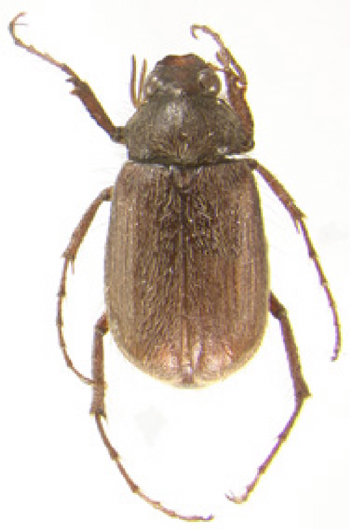Generic and species Diagnosis:
Measurements: Prothorax
at widest point 3.8 mm, elytra at widest point 6.0 mm, length 10.5 mm.
Color and vestiture: Body reddish brown, with vestiture consisting of
long whitish setae.
Head: Clypeus coplaner with frons; frons angled at 30°; labrum in
frontal profile narrow, ovate, weakly emarginate; labium with prementum
quadrate, ventral surface with a broad, shallow medial groove; antennae
9-segmented, segments 7-9 forming an elongate club, the length of which
equal to combined length of segments 2-6.
Prothorax: Pronotum oblong, transverse, widest medially, anterior angles
obtuse, lateral margins convex, serrate, posterior angles obtuse, posterior
margin straight, medially lobed; coxae transverse, tibia with dorsal
margin bidentate; pretarsus with claws divergent, equal in length, claws
widely split.
Mesothorax: Scutellum subtriangular; elytra longer than wide, widest
medially, elytral epipleuron narrow, flattened, dorsal surface with weak
striae, interstrial regions slightly raised, surface with short, white
setae, anterior umbone well developed, posterior umbone absent; pretarsus
similar to prothoracic pretarsus.
Metathorax: Metathoracic leg with coxae narrowly separated; femur narrow,
widest medially; tibia vase shaped, widest medially, narrowed in proximal
1/4, posteroventral margin lacking spurs, posterior margin with a shallow,
U-shaped groove; pretarsus with claws similar to those of prothoracic
legs.
Abdomen: Ventrites 1-3 equal in length, 4th ventrite (= propygidium)
equal in length to ventrites 2-3 combined, posterior margin membranous,
ventrite and sternite of 4th abdominal segment not separated by a distinct
suture; 5th ventrite equal in length to that of ventrite 2; pygidium
large, subtriangular, width subequal to length.


